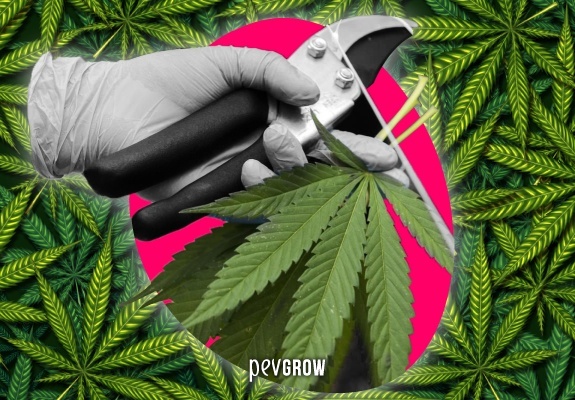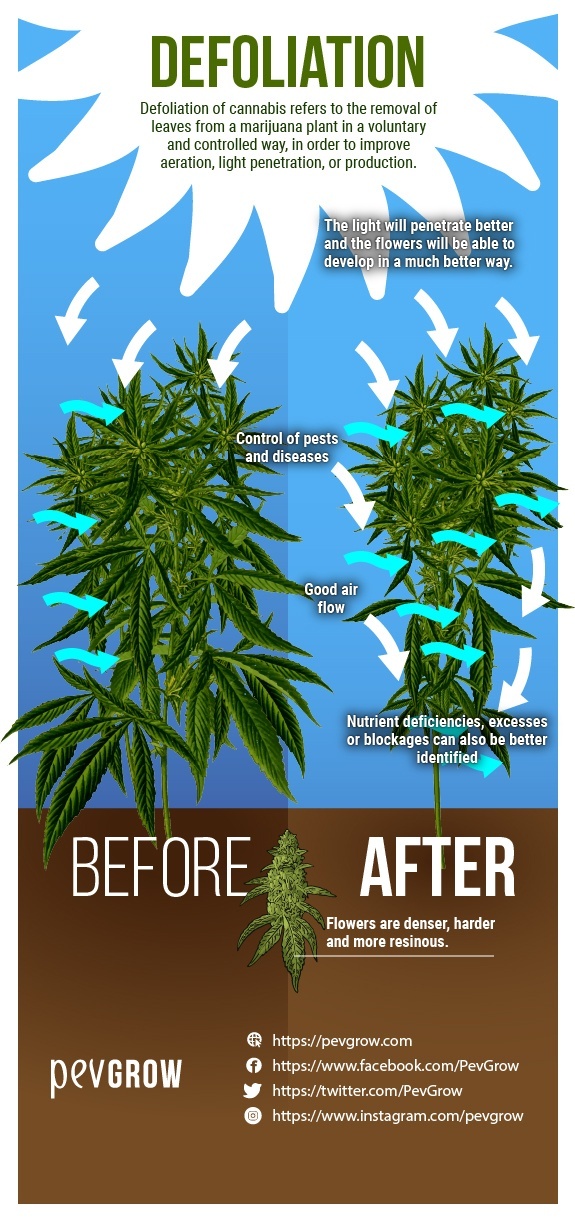

05-03-2021 16:00:00 - Updated: 5 March, 2021
I’m sure you’ve heard the word defoliation more than once and have wondered… What is that? That has happened to all of us at some point, and for that reason we have decided to create this article, trying to make clear what it is, how it is done, what it is for and what is the right time to do it.
⭐ What is defoliation?
Although the actual definition of defoliation refers to the premature fall of some plant leaves due to different factors, in our case it is not. Defoliation of cannabis refers to the removal of leaves from a marijuana plant in a voluntary and controlled way, in order to improve aeration, light penetration, or production in the aerial parts of the plants.
This method is not exclusive to pot plants, it has been used in many other crops for centuries, both in ornamental plants such as bonsai and in intensive agriculture for food. Defoliation carries certain risks, but if it is done well it is worth it, so it is interesting to know how to carry it out.
⛳ What is achieved with this technique?
When you do not remove the leaves from certain parts of the plant, the energy of the plant is distributed equally throughout the structure, but of course, those areas not well lit, or where the light doesn’t penetrate well, can not get to form the buds you can see in the high or clear parts. On the other hand, if you pluck some of these leaves, the light will penetrate better and the flowers will be able to develop in a much better way.
But you don’t just earn buds or harvest weight, with defoliation applied to cannabis cultivation you will see that flowers are denser, harder and more resinous. This is because the extra light and ventilation that some parts of the plant get with this special pruning technique allows you to make better use of the energy to finish forming those buds well.
Another added advantage is the control of pests and diseases, since by leaving fewer leaves on the plants, insects have less room to hide and we can detect both insects and fungal foci more quickly. Nutrient deficiencies, excesses or blockages can also be better identified when the branches are clearer.
✨ When is it necessary to make defoliation to cannabis?
It can be done both in the vegetative growth phase and in pre-flowering, but we do not recommend doing it much later, because the plant would no longer have time to take advantage of the energy gained.
It is very common to make defoliation in the vegetative cycle to mother plants, mainly to bonsai. It is also interesting to make it during the growth to indica or hybrid plants with a lot of vegetative time, since there is a moment when the large leaves shade the new shoots, that is a good moment to perform defoliation.

👌 How to do cannabis defoliation
It’s not difficult, but you can’t do it in a crazy way, because the leaves are the solar panels and the nutrient reserves that the plants have, so you have to choose very well the ones that you are going to eliminate. You also have to take into account that every time you make a cut to a plant you are opening a door for possible infections, so be careful and do it only where it is necessary.
You only have to remove the largest leaves in case they block the light to the sprouts, leaving the branches more visible, aired and illuminated by all its extension. In the following drawing you can see an example:
If you pay attention, you will see that the branches continue having some leaves, just next to the buds where the flowers will come out, but the biggest ones have been removed, those which the petiole comes out right in the knots of the main trunk.
📲 When is it not convenient to perform defoliation?
There are times when, due to the vital state of the plants, it is better not to defoliate, since it would not gain yield, on the contrary, it can even be negative. When a plant has deficiencies, plagues, blockages, or some other type of stress, it is not good to remove its leaves, because in that state the only thing that is achieved is that it is stressed even more and may even die if its situation is not reversed.
Although not everyone agrees, from our point of view it is not good to apply defoliation to normal autoflowering plants. There are very dense XXL autos which can improve the production with this technique, but in general with varieties of automatic flowering you do not profit much, and the risk of irreparable damage is higher.
🚀 Extreme defoliation or radical lollipop
There are some growers, especially in America, who perform an intense defoliation, so much so that they barely leave the tips of the branches intact. This variation of the technique defoliation is also called Lollipoping, since the plants are shaped like lollipops, very similar to excessive low pruning. We are not very fond of doing this, except in certain cases.
Among these exceptions are plants that have been used for a long time as a contribution of cuttings, that is to say, big mother plants which are going to go into bloom. In many cases these plants generate very woody stems in the low zones and develop well only in the tips of the branches.
🎯 Conclusion
Today we have seen a production optimization technique that has some followers and many detractors. In case you didn’t understand, it’s better to leave more leaves than to remove some essential ones, but removing the necessary ones will increase the production and the final quality of the harvest. I hope you liked this article and, if possible, you could share it.






hello…now with new led products and techs, defoliation is became totally obsolet. for me it s just stupid to think that defoliating is the best way to have better yield. leaves are solar panels that ensure good cellular development of the overalll plant, but also are tanks for mobile or semi mobiles nutrients. More they alllow to diagnose perfectly by their study (older or younger leaves) what can be wrong in your grow like deficiencies or overfeeding….cut them and you will loose all this benefits. sog and crog are also for me obsolet….all that grow techs was efficient with all older growlight material (hps cmh etc) but with led it’s time to think differently.